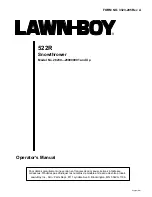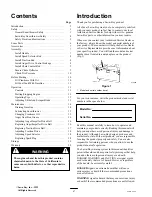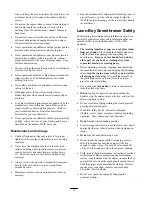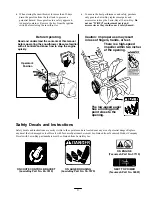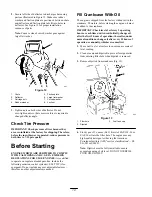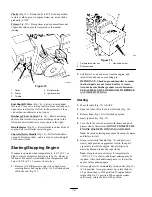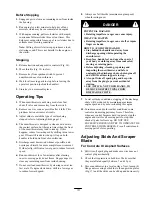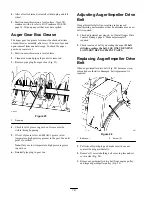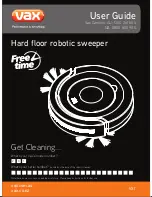
3
CAUTION signals a hazard that may cause minor or
moderate injury if the recommended precautions are not
followed.
Two other words are also used to highlight information.
“Important” calls attention to special mechanical
information and “Note” emphasizes general information
worthy of special attention.
The left and right side of the machine is determined by
standing behind the handle in the normal operator’s
position.
Safety
To ensure maximum safety, best performance, and to
gain knowledge of the product, it is essential that you
and any other operator of the snowthrower read and
understand the contents of this manual before the
motor is ever started. Pay particular attention to the
safety alert symbol
which means CAUTION,
WARNING OR DANGER — “personal safety
instruction.” Read and understand the instruction
because it has to do with safety. Failure to comply with
instruction may result in personal injury.
The snowthrower is designed and tested to offer
reasonably safe service; however, failure to comply with
the following instructions may result in personal
injury.
General Snowthrower Safety
The following instructions have been adapted from the
ANSI/OPEI standard B71.3—1995 and ISO standard
8437:1989. Information or terminology specific to
Lawn-Boy snowthrowers is enclosed in parenthesis.
Training
•
Read the operator’s manual carefully. Be thoroughly
familiar with the controls and the proper use of the
equipment. Know how to stop the unit and disengage
the controls quickly.
•
Never allow children to operate the equipment. Never
allow adults to operate the equipment without proper
instruction.
•
Keep the area of operation clear of all persons,
particularly small children and pets.
•
Exercise caution to avoid slipping or falling, especially
when operating in reverse.
Preparation
•
Thoroughly inspect the area where the equipment is to
be used and remove all doormats, sleds, boards, wires,
and other foreign objects.
•
Disengage all clutches and shift into neutral before
starting the engine.
•
Do not operate the equipment without wearing
adequate winter garments. Wear footwear which will
improve footing on slippery surfaces.
•
Handle fuel with care; it is highly flammable.
•
Use an approved fuel container.
•
Never add fuel to a running or hot engine.
•
Fill fuel tank outdoors with extreme care. Never
fill fuel tank indoors.
•
Replace gasoline caps securely and wipe up spilled
fuel.
•
Use only the power cord supplied with the
snowthrower and a receptacle appropriate for use with
the cord for electric starting motors.
•
Adjust the collector (auger) housing height to clear
gravel or crushed rock surface (this is not necessary on
single-stage snowthrowers).
•
Never attempt to make any adjustments while the
engine is running, except where specifically
recommended by manufacturer (Lawn-Boy).
•
Let engine and machine adjust to outdoor temperatures
before starting to clear snow.
•
The operation of any powered machine can result in
foreign objects being thrown into the eyes. Always
wear safety glasses or eye shields during operation or
while performing an adjustment or repair.
Operation
•
Do not put hands or feet near or under rotating parts.
Keep clear of the discharge opening at all times.
•
Exercise extreme caution when operating on or
crossing gravel drives, walks, or roads. Stay alert for
hidden hazards or traffic.
•
After striking a foreign object, stop the engine, remove
the wire from the spark plug, thoroughly inspect the
snowthrower for any damage, and repair the damage
before restarting and operating the snowthrower.
•
If the unit should start to vibrate abnormally, stop the
engine and check immediately for the cause. Vibration
is generally a warning of trouble.
•
Stop the engine whenever you leave the operating
position, before unclogging the collector
(auger)/impeller housing or discharge guide (chute),
and when making any repairs, adjustments, or
inspections.
•
When cleaning, repairing, or inspecting, make certain
the collector (auger/rotor blades)/impeller and all
moving parts have stopped. Disconnect the spark-plug

